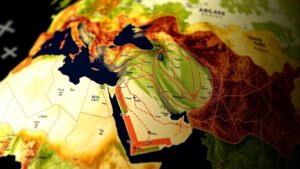How AI Combines Historical Trade Data to Uncover Ancient Gemstone Routes
Introduction
The study of ancient trade routes reveals significant insights into cultural exchanges and economic interactions across civilizations. Artificial Intelligence (AI) has emerged as a transformative tool in archaeological research, particularly in the analysis of historical trade data. This article examines how AI methodologies synthesize historical records to uncover ancient gemstone trade routes, illuminating connections between various cultures from antiquity.
The Historical Context of Gemstone Trade
Gemstones have held intrinsic value across many ancient cultures, often symbolizing wealth and status. trade of these precious stones facilitated not only economic growth but also the exchange of ideas and technologies. Significant routes, such as the Silk Road, were critical for the distribution of gemstones like diamonds, sapphires, and emeralds, which played pivotal roles in regional economies.
Significant Gemstone Trade Locations
Key historical locations involved in gemstone trade include:
- India: Known as the source of diamonds for centuries, India’s Golconda mines were renowned for the production of high-quality diamonds.
- Myanmar: The region has long been a significant source of rubies and jadeite, which were crucial in trade with the Chinese Empire.
- Middle East: The Persian Gulf trade routes facilitated the flow of various gemstones, including turquoise and agate, towards Europe.
The Role of AI in Historical Trade Analysis
Artificial Intelligence techniques such as machine learning and data mining allow historians and archaeologists to analyze extensive datasets efficiently. By processing historical texts, trade records, and archaeological findings, AI can identify patterns that were previously invisible to researchers.
Data Integration from Multiple Sources
AI systems can integrate data from diverse formats including:
- Archaeological Reports: Details about gemstone finds in excavations.
- Historical Texts: Accounts of trade from travelers and merchants, such as the writings of Marco Polo.
- Trade Records: Manuscripts documenting exchanges of goods, including gemstones.
Machine Learning Techniques
Machine learning algorithms, like clustering and regression analysis, are particularly effective in analyzing trade routes. For example, clustering algorithms can group similar trade patterns based on historical trade volumes, revealing predominant trade routes over time.
The Application of AI on Specific Gemstone Routes
AI has been employed to uncover various trade routes, illuminating the interactions between cultures. One significant application involves tracing the route of diamonds from India to Europe.
Case Study: The Indian Diamond Trade
Using a combination of historical databases pertaining to gem exports and trade routes, researchers have utilized AI to map the journey of diamonds from the Golconda mines to European markets during the 16th century. The integration of data revealed:
- Trade Centers: Major hubs in Lisbon and Venice emerged as critical nodes in the diamond trade.
- Transportation Networks: The study highlighted the various maritime and overland routes taken by merchants.
Implications of Findings
The understanding of ancient gemstone trade routes illuminates historical economic practices and cultural interactions. For example, the discovery of certain gemstones in non-native regions suggests a complex web of trade relationships extending far beyond local economies.
Future Directions of Research
The intersection of AI and historical trade analysis holds great potential for future research. Possible avenues include:
- Enhanced Data Sources: The incorporation of satellite imagery and geographic information systems (GIS) to analyze trade routes more comprehensively.
- Interdisciplinary Collaborations: Partnerships between data scientists, historians, and archaeologists could yield richer insights.
Conclusion
Artificial Intelligence stands at the forefront of archaeological research, particularly in unraveling the complexities of ancient gemstone trade routes. By integrating historical databases and applying machine learning techniques, AI allows researchers to reveal trade patterns that encompass both economic and cultural dimensions. As technology evolves, the potential for uncovering further historical insights through AI will only increase, paving the way for a deeper understanding of our shared past.
Takeaways
- The integration of AI into historical research enhances the analysis of trade routes and economic interactions.
- Key historical trade locations such as India, Myanmar, and the Middle East played significant roles in gemstone distribution.
- Future research utilizing advanced technologies promises to further illuminate ancient trade networks and relationships.


